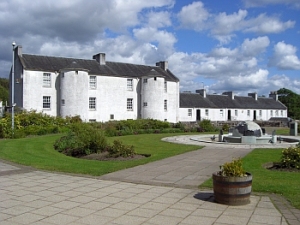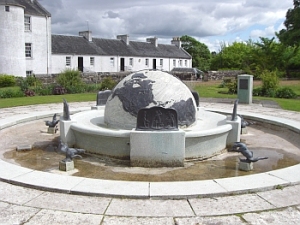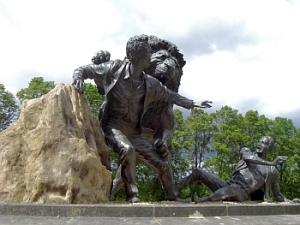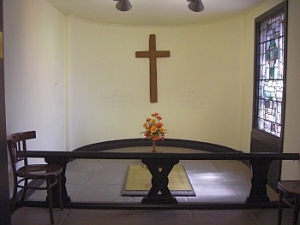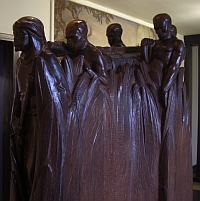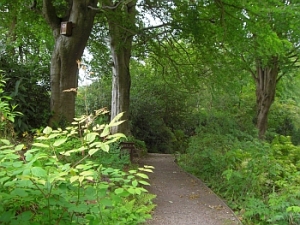Our walk today is from Bothwell Castle to the Palace Grounds in Hamilton. This is just over 6.5 miles ending at Hamilton outside the Mausoleum, final resting places of the Dukes of Hamilton.
Bothwell Castle
As the journey is starting and finishing at different points, we take a bus to Uddingston, getting off at the bus stop just before Uddingston Cross. We walk down a road to the left, next to the police station, and turn left onto Castle Avenue.
We pass the Cricket and Athletic ground and some lovely houses. The area we are in is popular with professional people and footballers. After about half a mile we arrive at the road leading to the Castle.
It is a bright, crisp, sunny January day and there are a number of people out walking, many with dogs. The castle is looking good in the winter sunshine. It dates from the 13th century and is an outstanding monuments remaining from this period.
Historic Significance
It was built by Walter of Moray, a northern aristocratic family who acquired Bothwell in 1242. It has been described as ‘the grandest piece of secular architecture that the Middle Ages has bequeathed to us in Scotland’ by Dr W. Douglas Simpson, librarian of King’s College at the University of Aberdeen.

It figured in the Wars of Independence with England and numerous sieges, the most important being Edward I’s great siege of 1301. Edward I of England was also known as ‘Hammer of the Scots’ and he brought 6,800 soldiers to the castle hauling a huge siege engine, called le berefrey (‘the belfry’), from Glasgow.
This was a tall siege tower, with ladders inside and allowed the attackers to fight their way onto the castle battlements. The garrison surrendered within the month.
As we arrive at the main entrance to the castle, I point out a tree on our right with some gregarious birds perched at the top. I identify them as Jackdaws and they roost in one of the towers in the castle at night.
Inside the Castle

We enter the castle, which is maintained by Historic Scotland. There is a small shop near the entrance which sells some refreshments and quality goods.
We tour the castle, imagining life in the 13th century as we go along. It must have been an impressive structure when it was built. We complete our visit to the castle by walking round the perimeter wall.
Clyde Walkway to Blantyre
We then take a path to the south of the castle which runs parallel with the River Clyde towards Blantyre. As we walk along, we hear the singing of Blue Tits and Great Tits, and on our right, on the Clyde, we see two pairs of Goldeneye ducks.
Dr David Livingstone

We soon come to a small iron bridge which crosses the river to Blantyre. African explorer, Dr David Livingstone was born here on March 13, 1813. We can see the house from the other side of the river. (For more on Dr Livingstone, please see the article here).
We cross the bridge and re-join the walkway towards Strathclyde Park. The river is now on our left and we are quite close to the river. The path is well defined, but after about 1.5 miles, it becomes harder to see. We continue on a smaller path which eventually leads us into a field.
This is quite boggy and reminiscent of the Campsies. The field is enclosed in temporary fencing which makes it harder to find the way ahead. The OS map has a path clearly marked but we are unable to find it. The problem seems to be as a result of the demolition of a building – probably Craighead – which has turned this part of the walkway into a building site.
Finding our Way
We decide to walk to the road and then try to find the path further along. Getting out of the field is difficult with all the fencing, but we do find a gap to take us to the main road.
We walk along the footpath next to the A725 and can see Strathclyde Loch in the distance. After quarter of a mile, we see steps which lead us to a walkway which will take us to Bothwell Bridge.
Battle of Bothwell Bridge

There was a battle here on 22nd June 1679. It was fought between government troops and militant Presbyterian Covenanters and signalled the end of their brief rebellion. (For more on the Covenanters, please see the article here).
After walking across the bridge, we cross the busy Bothwell Road and continue on the path towards Strathclyde Park. The path follows the River Clyde for about 40 meters before turning west towards the main entrance to Strathclyde Park.
Strathclyde Park
We are walking through some grassland with the busy A725 on our left. A large pond can be seen on our right, but there does not seem to be any wildlife in it or on the meadow.
After about 10 minutes, we arrive at a busy junction and have to carefully cross two slip roads before arriving at Strathclyde Park. We climb some steps towards the Toby Carvery and continue on a footpath past some ash parks and arrive at the west side of Strathclyde Loch, which is situated in the park.
Strathclyde Loch

This is the side of the loch which is used for start of rowing events. Major events held at the loch in recent years include the rowing events for the 1986 Commonwealth Games, the 1996 Junior World Rowing Championships, the 2005 World Rowing Masters Regatta and the 2006 Commonwealth Rowing Championships.
Strathclyde Loch is an artificial loch located next to the River Clyde between Hamilton and Motherwell. it is situated in the area which used to be known as the Low parks of the now demolished Hamilton Palace. It was created in the early 1970s when the old mining village of Bothwellhaugh was flooded.
Waterbirds
As we walk along footpath, the loch is on our left. A few rowers from the rowing club are out on the water and some sailing boats can be seen in the distance. Large flocks of gulls with some Canada Geese, Mallard Ducks and some Mute Swans are on the other side of the loch.
The footpath is very busy with walkers, runners and cyclists, probably encouraged by the pleasant winter weather. Many people walk round the loch for exercise, while others come to look at the wildlife and the birds in the surrounding area.
Home to Roost

We walk at a brisk pace towards the main building at the east side of the loch. Many birds can be seen close-up at this part of the loch. Today we are fortunate to see Mute Swans, Canada Geese, Greylag Geese and many different types of gulls, as dusk is approaching and the birds are coming ashore to roost.
We stop to look at the birds for 20 minutes before continuing on our way to the main buildings in the park. We will now cross a small footbridge over the River Clyde towards Hamilton and walk through the Palace Grounds, where Hamilton Palace once stood.
Hamilton Palace and Mausoleum
Hamilton Palace was the former seat of the Dukes of Hamilton. It was built in 1695 and demolished in 1921 due to ground subsidence. It was one of the grandest houses in Scotland.
Hamilton Mausoleum, final resting place of the Dukes of Hamilton, still stands in the grounds. It is a Roman-style domed structure of panelled masonry and is the solitary remaining testament to the scale and grandeur of the buildings which once stood in the Hamilton Low Parks. It has the longest-lasting echo of any building in the world.
We stop to look at the Mausoleum. It is now surrounded by a high fence to prevent damage to it so we are unable to get close to it. It is possible to visit the interior by making an appointment with staff at the Low Parks Museum.
All the coffins from the Mausoleum were re-buried in Hamilton’s Bent Cemetery due to the subsidence and flooding which affected the building.
We are now coming to the end of our walk and we walk along a footpath past some small football pitches towards the main shopping centre in Hamilton.
Further Information
Bothwell Castle: Grid Ref: NS 688 593
Strathclyde Loch: Grid Ref: NS728567
Travel Details
Road – Travel to Uddingston Cross and follow Castle Avenue to Bothwell Castle.
Public Transport – Train to Uddingston and walk 0.5 miles to the Castle.
First Bus no 255 from Glasgow or Hamilton. Alight at Uddingston Cross.
Historic Scotland – http://www.historic-scotland.gov.uk/
North Lanarkshire Council – http://www.northlanarkshire.gov.uk/index.aspx?articleid=1
South Lanarkshire Council – http://www.southlanarkshire.gov.uk/
